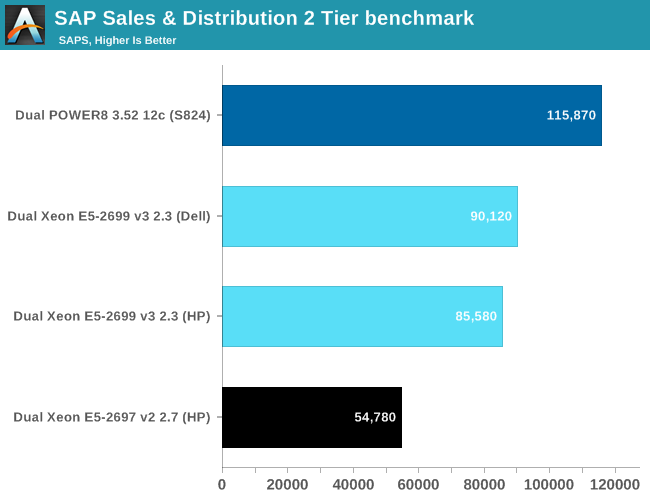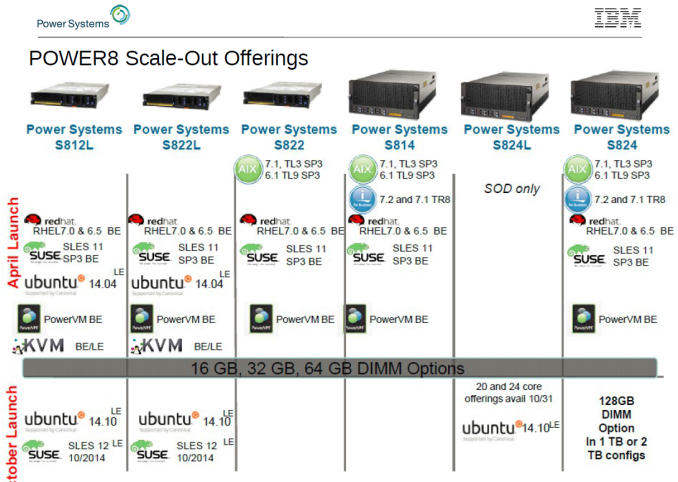The IBM POWER8 Review: Challenging the Intel Xeon
by Johan De Gelas on November 6, 2015 8:00 AM EST- Posted in
- IT Computing
- CPUs
- Enterprise
- Enterprise CPUs
- IBM
- POWER
- POWER8
Reading the Benchmarks
There are a lot of benchmarks available that compare the IBM POWER8 to Xeons. One example is the Enterprise Resource Planning (ERP) software SAP. We have used the Sales & Distribution 2 Tier benchmark many times because it is one of the very few benchmarks that is a very good representation of real world high-end enterprise workloads.

Now combine this with the benchmarks that IBM has compiled on their marketing slides and the fact that we know that the POWER8 chip has a TDP of 190W at nominal speed and 247W when running at "Turbo" clockspeeds.
It all seems very simple: the IBM POWER8 is a more power hungry chip but delivers much better performance. But as always you should take the time to read the benchmarks very closely. The IBM S824 is typically the one featured in the benchmarks. However, we are pretty sure that is not the system that will be able to sway the current Intel Xeon customers towards OpenPOWER. Nor are we convinced that the most widely reported benchmarks are accurately predicting the experience of those people.
There are three reasons for that. First of all, most of the benchmarks are run on AIX (7), IBM's own proprietary UNIX. AIX is a high performance, extremely robust OS, but it does not have the rich software system and support that Linux has. Furthermore even with their common design elements, an excellent Linux administrator will have to invest some time to get the same level of expertise in AIX. But more importantly, the S824 is a pretty expensive machine, both in acquisition cost (starting at $21.000, up to $60.000 and more) and energy cost. That kind of pricing lands the system in hostile and more powerful quad Xeon E7 territory.
Lastly, the S824 uses two CPU cards or Dual Chip Modules (DCM), each containing two six-core POWER8 modules at 3.5 GHz. Now consider that the third party OpenPOWER servers have 190/247W TDP 10-core 3.4 GHz POWER8 CPUs. The power consumption does not increase linearly as you add more cores and higher clocks. So the CPU modules found inside the S824 are definitely more power hungry, probably well above 250W.
There is more. Take a look at IBM "Scale-out" server, the more affordable server range of IBM servers. First, a bit of IBM server nomenclature which is actually quite logical and easy to decipher (take note, Intel marketing).
- S stands for "Scale-out"
- 8 stands for POWER8
- 1 or 2 is the number of sockets
- 2 or 4 is the height, expressed in rack Us.
So an S824 contains 2 sockets in a 4U chassis and a S812 is a one socket system. There is one designation left, : the "L" or Linux .
Notice that the non-L versions also support Linux, but a few months ago they supported only the Big Endian (BE) versions (the slide is from the beginning of this year). IBM told us that all POWER8 servers now support both Little Endian (LE) and BE Linux.
This is important since using an LE version (Ubuntu, SUSE) makes data migration from and data sharing (NAS, SAN) with an x86 system much easier, as x86 only supports LE.












146 Comments
View All Comments
JohanAnandtech - Saturday, November 7, 2015 - link
suggestions on how to to do this? OpenSSL 1.02 will support the build in crypto accelerator, but I am not sure on how I would be able to see if the crypto code uses VMX.SarahKerrigan - Monday, November 9, 2015 - link
Compile with -qreport in XL C/C++.Oxford Guy - Saturday, November 7, 2015 - link
Typo on page 2:The resuls are that Google is supporting the efforts and Rackspace has even build their own OpenPOWER server called "Barreleye".
Ryan Smith - Saturday, November 7, 2015 - link
Thanks.iwod - Saturday, November 7, 2015 - link
In terms of 100, POWER Software Ecosystem manage to scale from 10 to 20, so that is a 100% increase but still very very low. Will we see POWER CPU / Server that is cheap enough to compete with Xeon E3 / E5, where most of the volume are? Compared to E7 is like comparing Server CPU for the 10% of the market.Intel will be moving to 14nm E7, I don't see anyone making POWER CPU at 14nm anytime soon.
Intel DC business are growing, and it desperately need a competitor, such as POWER to combat E7 and AMD Zen from the bottom.
Frenetic Pony - Saturday, November 7, 2015 - link
Nice review! It just confirms my question however of "What does IBM do?" Seriously, what do they do anymore? All I see are headlines for things that never come out as actual products. Their servers suck up too much power per watt, they don't have their own semi conductor foundries, their semi conductor research seems like a bunch of useless paper tiger stuff, their much vaunted AI is better at playing Jeapordy than seemingly any real world use.Countdown to complete IBM bankruptcy/spinoff/selloff is closer than ever.
ws3 - Saturday, November 7, 2015 - link
Since the dawn of computing, IBM has been in the business of providing solutions, rather than merely hardware. When you buy IBM you pay a huge amount of money, and what you get for that is support, with some hardware thrown in.Obviously this only appeals to wealthy customers who don't have or don't want to have an internal support organization that can duplicate what IBM offers. It seems to me that the number of such customers is decreasing over time, but as long as the US government is around, IBM will have at least one customer.
xype - Sunday, November 8, 2015 - link
They make 2-5 Billion dollars of profit per quarter. "Countdown to complete IBM bankruptcy/spinoff/selloff is closer than ever." my ass.PowerTrumps - Sunday, November 8, 2015 - link
Pretty fair and even handed review; don't agree with it all and definitely feel there is room to learn and improve. Btw, full disclosure, I am a System Architect focusing on Power technology for a Business Partner.With regard to compilers I would suggest IBM's SDK for Linux on Power & Advanced Tool Chain (ATC) provide development tools and open source optimized dev stack (ie gcc) for POWER8. Details at: https://www-304.ibm.com/webapp/set2/sas/f/lopdiags... and https://www.ibm.com/developerworks/community/wikis...
MySQL is definitely relevant but with the new Linux distro's packaging MariaDB in place of MySQL I would have liked to see an Intel vs Power comparison with this MySQL alternative. MariaDB just announced v10.1 is delivering over 1M queries per second on POWER8. https://blog.mariadb.org/10-1-mio-qps/
A commenter asked about Spark with POWER8. This blog discusses how it performs vs Intel. https://www.ibm.com/developerworks/community/blogs...
In addition to the commercial benchmarks often quoted such as SPEC, SAP and TPC like this SAP HANA result with SUSE on POWER8 ; SAP BW-EML (ie HANA) shows tremendous scaling with POWER8. http://www.smartercomputingblog.com/power-systems/... many of the ISV's have produced their own. I have seen results for PostgreSQL, STAC (http://financial.mcobject.com/press-release-novemb... Redis Labs, etc.
Benchmarks are great, all vendors do them and most people realize you should take them with a grain of salt. One benefit of Power servers when using PowerVM, its native firmware based hypervisor is that it delivers tremendous compute efficiency to VM's. On paper things like TDP seem higher for Power vs Intel (especially E5_v3 chips) but when Power servers deliver consolidation ratio's with 2-4X (and greater) more VM's per core the TCA & TCO get real interesting. One person commented how SAP on Power would blow out a budget. It does just the opposite because how you can run in a Tier-2 architecture obtaining intra-server VM to VM efficiencies, compute efficiencies with fewer cores & servers which impacts everything in the datacenter. Add in increased reliability & serviceability features and you touch the servers less which means your business is running longer.
And for more details on the open platform or those based on the OpenPOWER derivative using the "LC" designator such as S822LC in contrast to the S822L used as the focus in this article. http://www.smartercomputingblog.com/power-systems/... and http://businesspartnervoices.com/ibm-power-systems...
JohanAnandtech - Sunday, November 8, 2015 - link
Great feedback. We hope to get access to another POWER8(+) server and build further upon our existing knowledge. We have real world experience with Spark, so it is definitely on the list. The blog you linked seems to have used specific SPARK optimization for POWER, but the x86 reference system looks a bit "neglected". A real independent test would be very valuable there. The interesting part of Spark is that a good benchmark would be also very relevant for the real world as peak performance is one of the most important aspects of Spark, in contrast with databases where maximum performance is only a very small part of the experience.About MySQL, people have pointed out that the 5.7 version seems to scale a lot better, so that is together with MariaDB also on my "to test" list. Redis does not seem relevant for this kind of machine, it is single-threaded, almost impossible to test 160 instances.
The virtualization part is indeed one of the most interesting parts, but it is a benchmarking nightmare. You got to keep response times at more or less the same levels while loading the machine with more and more VMs. We did that kind of testing until 2 years ago on x86, but it was very time consuming and we had a deep understanding on how vSphere worked. Building that kind of knowledge on PowerVM might be beyond our manpower and time :-).